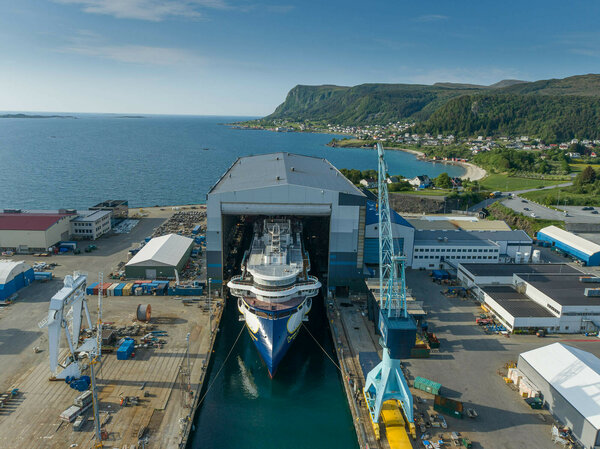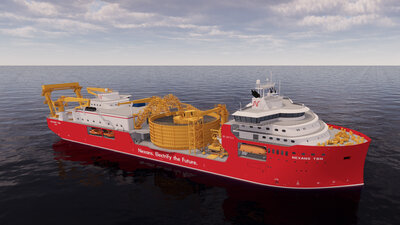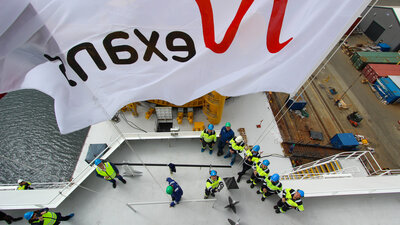This cost of delayed delivery can relate to the loss of charter contracts or customers, or the need to charter another vessel to do the job the newbuilding was supposed to do. In other cases, the shipowner must take over the responsibility of finalizing the construction of the vessel, including the cost relating to financing and other indirect costs.
The size and complexity of the vessel dictate the time required to build. Thus, although it is of the shipowners' interest to get a short building period, it is not always straightforward. In the latter years, we have seen many complex vessel constructions accumulating substantial delays, which have had a negative impact on the owners and the shipbuilder.
Cruise vessel newbuildings
One example is exploration cruise vessels. These vessels are small to medium-sized vessels offering cruises to unique destinations like Galapagos, the Arctic, and Antarctica. In many cases, the vessels have special features such as ice strengthening, Zodiacs and hangars, swimming pools and many other amenities that make the experiences and life onboard unique. Yet, they also increase the complexity of the vessels' construction.
The shipbuilding market of exploration cruise vessels experienced a historically high activity in the period 2016 to 2018, to cater for a strong and growing increase in passengers. This market interest led to a strong focus on short delivery times.
The average delay on the 32 vessels delivered in the period 2017-2021 was 139 days. Thus, on average, cruise companies received their newbuildings almost five months later than initially contracted ? in other words, the vessels lost a cruising Polar season.
Nine of those vessels accumulated a delay of more than six months, of which five were delayed for almost one year.
Only eight vessels were delivered within 30 days of the contractual delivery date.
Renowned for punctual deliveries
Ulstein Verft is renowned for punctual deliveries and recently delivered the exploration cruise vessel 'National Geographic Resolution' on the agreed date of delivery.
The 'Resolution' was delivered in the last week of October 2021 from the shipyard in Norway and was already fully operational in Antarctica by mid-November. The vessel was built during an international pandemic that limited to a large extent international travelling and jeopardized the work of many suppliers that had to bring their supplies and workers to the vessel.
The 2020 photo below shows the 'Resolution' (right) and her sister vessel, the 'National Geographic Endurance', at different stages of completion. The cable-laying vessel 'Nexans Aurora', of which only the aft end can be seen in the photo, is here under construction inside the dock hall.
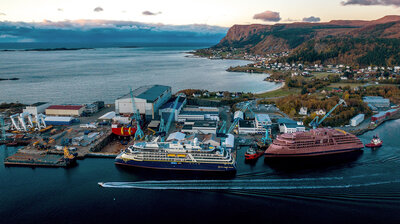
Cable-laying vessels and the importance of on-time deliveries
The cable-laying vessel Nexans Aurora is another example of an on-time delivery from Ulstein Verft. For cable laying vessels, on-time delivery is critical as they have multi-million commitments for the installation of cables. Delays in the delivery can delay cable projects and subsequently the projects requiring the cables, such as the wind farms. Otherwise, the vessel owner will need to charter an external vessel to perform the work, with the cost implications it carries.
How does Ulstein Verft manage to deliver such complex projects on time?
There are three main reasons to explain the ability to punctual deliveries, these are a skilled workforce, competent management of newbuilding projects and the supply chain and modern facilities which includes a covered dock.
1. Competent resources
The employees are the single most important resource in Ulstein and the main reason for the successful performance of Ulstein Verft. The accumulated expertise in the highly skilled workforce has been transferred from generation to generation of shipbuilders since 1917.
Understanding the vessel, its operations, and the technology on board are essential elements for a successful shipbuilding project. Ulstein, as an integrated designer, shipbuilder and lifecycle service provider, holds a unique, combined strength.
2. Project and supply chain management
The project and supply chain management play an essential role in the effective use of resources.
Collaboration along the value chain defines the success of complex projects. This has been tested during Covid-19, where travelling restrictions imposed an even more challenging environment for collaboration with suppliers.
Vessels for segments such as exploration cruise, Ropax, service operation (offshore wind) or cable laying require a set of expertise that is not broadly available. There are only a few companies capable of supplying critical systems such as gangways, cable spreads or tender launching systems. Ulstein has developed in-house expertise and built up a strong collaboration with a network of suppliers for such critical system deliveries.
Ulstein has, over the years, collaborated with recognised universities nationally and internationally to further develop existing knowledge on shipbuilding strategies. The following figure reflects a recent study evaluating the impact of four shipbuilding strategies on delivery time and production hours.
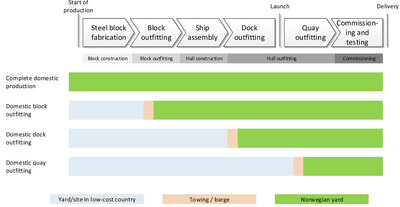
3. State-of-the-art facilities
Ulstein Verft's covered dock offers a competitive advantage with regard to product quality and working conditions. The covered dock is also exploited with regard to shipbuilding efficiency. Planning of activities can be decoupled from weather conditions since rain, wind or snow will not impact the ongoing work in the dock.
The compact yard with its location of storage and auxiliary systems also play an important role in enhancing productivity and securing on-time delivery of vessels. Ulstein's facilities ensure close by storage and easy access of personnel and equipment to the vessels, either at the dock or at one of the three outfitting quays available.
Close by the shipyard, there is an area to carry out sea trials. Thus, no major relocations are required to perform testing of systems, functionality, or seakeeping performance.
